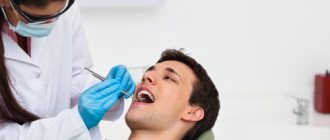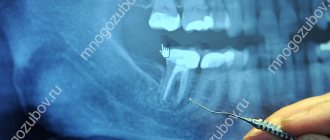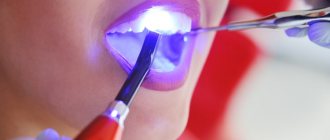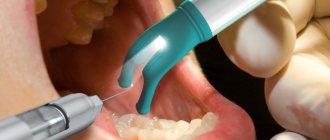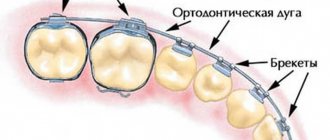Few people decide to undergo orthodontic treatment, believing that it is associated with high costs and discomfort. But often people’s fears are unfounded: installing braces is a multi-step, but safe process that goes without complications. We will tell you how orthodontic braces are placed and what stages this procedure includes.
In this article
- At what age are braces placed?
- Indications and contraindications for installing braces
- How braces are inserted: stages of orthodontic treatment
- How to install braces: diagnosis and treatment plan
- How to install braces: sanitation of the oral cavity
- Is it possible to put braces on crowns and fillings?
- How to install braces
- How to install braces: stages of the procedure
- Does it hurt to get braces?
- Braces activation
- How braces are placed on children and adults - is there a difference?
- How to care for braces
- How are braces removed?
Braces are installed primarily to correct the bite or straighten unevenly growing teeth. According to statistics, about 75% of children have problems with bite. If they are not eliminated in childhood, they will affect the health of teeth and gums in the future. In addition, people with malocclusion and irregularities in the dentition often develop complexes, lower self-esteem and, as a result, have difficulties in building interpersonal relationships.
Today, this problem can be solved in just a few years; you just need to install braces - dental brackets that are fixed to the dentition from the inside and/or outside and gradually straighten the teeth to a normal state. There are many rumors and myths surrounding the topic of orthodontic appliances.
Many people believe that getting braces is dangerous and painful, they cause discomfort, interfere with eating normally, etc. Such ideas are generated by ignorance. We'll tell you how braces are installed and how the preparation for their installation goes.
At what age are braces placed?
Braces are placed on both children and adults. Dentists say that the optimal age for orthodontic treatment with braces is 12-13 years. During this period, the final formation of the bite and the replacement of milk teeth with molars occurs. Pathologies in the structure of the dental system discovered in a teenager are eliminated faster than in adulthood.
In some cases, braces are placed earlier - at 8-11 years. However, if a person has missed this point, he can correct the problem as an adult. Of course, the treatment process will be longer, but no less effective. There is no upper age limit as such: an adult can be prescribed to wear braces as long as he has teeth, and bite correction is justified in terms of indications and contraindications.
What teeth are they placed on and what types of braces are there?
The classification of bracket systems is varied. The designs differ in materials, method of arch attachment, and location in the mouth. The following devices deserve interest:
- Vestibular – external braces for installation on the front (visible) surface of the teeth. When choosing this system, it is important to evaluate the characteristics of the material used, as it will determine the aesthetics and wearing comfort.
- Lingual - the structure is fixed on the lingual (inner) side of the dentition, which makes it invisible to others.
Based on the method of fastening the arch in braces, the following models are distinguished:
- ligature - fixation of elements among themselves is carried out using ligatures (rubber bands or small wires);
- non-ligating (self-ligating) – the power arc is tightly or loosely attached to the locking grooves of the plates.
When installing braces, the orthodontist will use the entire dentition - some of the plates will be visible in the smile area, the other part will be placed in an invisible area on the distant teeth. The material from which the braces are made will determine the aesthetics and will also affect the wearing comfort. Possible options:
- Metal ones are inexpensive and have been repeatedly tested in orthodontic treatment. They are capable of correcting even severe pathologies, but are not without drawbacks. Metal is more damaging to the mucous membrane when worn than other materials; it is unsightly and noticeable on the teeth.
- Ceramic – made to match the color of the enamel, they are practically invisible on the teeth. They cope well with correction, but are fragile and require care when worn. Due to the strength characteristics and the ability to be stained by food, certain restrictions are introduced into the patient’s eating habits.
- Sapphire - transparent and durable, do not change color from bright drinks and dishes. The most expensive of all designs, valued by teenagers and adults for their exceptional aesthetics.
- Plastic devices are short-term wearing devices, as they are unreliable, fragile and impractical.
Plaksina Margarita
For teenagers, I recommend the installation of combined braces - the visible part is made of an aesthetic material (sapphire, ceramics), and metal on the distant teeth. This combination gives optimal results and avoids the development of complexes in children.
Indications and contraindications for installing braces
Braces are placed to eliminate the following dental problems:
- malocclusion;
- uneven development of the jaws;
- anomalies of individual teeth;
- deformation of the dentition;
- chewing dysfunction;
- impacted teeth;
- large interdental spaces.
Contraindications to wearing braces can be absolute or relative. Among the first, which completely exclude the possibility of installing an orthodontic structure, are:
- absence of most of the teeth;
- some oncological pathologies;
- blood diseases;
- diseases of the endocrine system;
- very weak immunity;
- pathologies of the skeletal system;
- tuberculosis and HIV;
- psychiatric disorders.
Relative contraindications are temporary. These include:
- periodontal disease;
- caries;
- wounds in the oral cavity;
- metal implants;
- poor hygiene.
Braces can be placed only if the listed factors are eliminated. Indications and contraindications are identified during diagnosis - the first stage of installing orthodontic brackets.
Wax
As soon as the patient has joined the ranks of braces, the arsenal of tools and devices for caring for the apparatus and teeth should be expanded. For the first time after installation, you cannot do without special wax for braces.
At the initial stage of treatment, braces often cause discomfort and pain. Elements of the system rub lips and the inner surface of the cheeks. In many cases, this leads to the formation of ulcerative lesions in the mouth.
To prevent these unpleasant moments, experts recommend using a special wax for application to the orthodontic apparatus.
It provides reliable protection of soft tissues from injury. A small piece of the product is glued to the area of the system that causes damage to soft tissues.
During the adaptation period, you cannot do without wax plates for braces. Structural elements very often do not get along with the tissues of the oral cavity, which causes irritation and pain.
If discomfort does not disappear within 5 days of regular use, you should seek advice from your treating orthodontist.
How braces are inserted: stages of orthodontic treatment
The process of installing braces, that is, fixing them on the teeth, lasts about 1.5-2 hours. Preparation takes much more time. In general, treatment includes the following steps:
- Diagnostics: obtaining x-rays, on the basis of which braces will be made.
- Drawing up an individual treatment plan, advising the patient on preparation for the procedure.
- Sanitation of the oral cavity, treatment of diseases of the teeth and gums: caries, inflammatory processes, etc.
- Installation of an orthodontic structure, fixing it on the dentition.
- Assistance in adaptation: doctor’s recommendations regarding nutrition and care of teeth and braces during the treatment period.
Let's look at these stages in more detail.
How long do you wear braces?
How long braces are worn will primarily depend on the degree of curvature of the dentition. The duration of bite correction with braces in children will be on average from 1.5 to 2 years (with minor changes in the bite - about 1 year), but in adults - on average from 2.5 to 3 years. However, the duration of treatment depends not only on the curvature of the teeth, but also on the qualifications/experience of the orthodontist, as well as on the characteristics of the brace system you choose.
For example, if you install self-ligating braces (in which the metal arch is fixed not by ligatures, but by micro-locks), the treatment will almost always last longer. This is due to the fact that self-ligating braces only have passive ligation of the metal arch and there is no ability to switch the type of ligation from active to passive, and vice versa. This means that treatment at some stage may simply stall.
In addition, when choosing self-ligating ceramic braces, the treatment will be even longer, because the archwire fixation system in the form of ceramic micro-locks on the surface of the braces is a priori less reliable. Therefore, to avoid micro-locks breaking, orthodontists usually use “less force” tactics. This means that the teeth will experience less stress, and therefore their movement will take longer. But the slowest rate of tooth movement will certainly be with lingual braces (the so-called “invisible braces”).
Important: the movement of teeth in the bone tissue of the jaws (when wearing braces) a priori cannot be a quick process. The fact is that tooth movement occurs due to the process of “bone remodeling” around the roots of the teeth being moved. This process consists of parallel resorption of bone in the direction of movement of the tooth root, and its formation behind the direction of movement of the tooth root. That is why the treatment takes a long time.
How to install braces: diagnosis and treatment plan
Diagnostics allows you to identify contraindications, assess the condition of teeth and gums, take pictures and develop a further treatment plan. After the diagnostic examination, approximately a week passes, during which the doctor analyzes the material and draws up a plan for installing orthodontic structures. There may be several such plans and they differ in the method of fixing the braces or their type. The patient has the right to choose one of the proposed treatment options. Then the next stage begins - preparing the oral cavity for installation of the structure. Its duration is determined by the condition of the teeth and gums.
Stage 1 – consultation with an orthodontist
Although, strictly speaking, the first stage is an orthopantomogram. An orthomantomogram is a panoramic image of the entire jaw, allowing the doctor to assess the condition of the dentition, see problem teeth, places where there is not enough bone tissue. Understand whether preliminary sanitation, tooth extraction, etc. is necessary.
The validity period of an orthopantomogram is approximately six months. To avoid wasting time, do it right away.
You have come for a consultation, where the doctor, after an examination, will tell you about possible treatment options. He will estimate the cost of treatment, tell you about hygiene rules, etc. In general, you will receive all the information about the upcoming treatment.
As a rule, after a consultation, the patient thinks about what he heard and then makes a decision.
How to install braces: sanitation of the oral cavity
After installing braces, the procedure for brushing your teeth becomes noticeably more complicated and the risk of developing caries increases. To reduce it to a minimum, you need to eliminate all carious cavities. The main task of the dentist is to identify hidden foci of pathology that are located in the interdental spaces.
It is also necessary to eliminate inflammatory processes if they were detected during diagnosis. In other words, it is necessary to cure those pathologies that may become more complicated after installing braces. In addition, at the preparatory stage, ultrasonic cleaning is carried out, during which plaque and tartar are removed.
Some patients are worried that they will have to remove some teeth: “eights”, impacted ones, etc. Extraction is indicated in the following cases:
- crowded teeth;
- teeth that are too large (free-standing);
- presence of extra teeth;
- severe asymmetry of the jaws;
- decaying teeth that are useless to treat.
As a rule, if removal is necessary, it is wisdom teeth, which often erupt with complications: they grow to the sides, remain partially or completely in the gums and subsequently cause malocclusion.
Who should get braces?
Installation of a brace system is recommended in the following cases:
- For malocclusion - the correct closure of the teeth of the upper and lower jaws in children, adolescents and adults. Such violations occur very often, but in most cases they are invisible to the person himself and others. Severe malocclusions not only prevent a person from chewing food, but also cause speech disorders and an unattractive appearance.
- In case of an anomaly in the position of individual teeth: deviation of them outward or inward from the dentition, high or low position, gaps between the central incisors, rotation of the teeth around an axis, crowding in the dentition. All these anomalies are easily eliminated with braces.
- In the presence of unerupted (impacted) teeth. Most often these are the upper canines, lower wisdom teeth and small molars. Retention is associated with a lack of space in the dentition due to premature removal of baby teeth or improper development of the jaw. Installing a braces system allows you to expand the interdental spaces and allow impacted teeth to take their place in the dentition.
- If necessary, corpus movement of the teeth - simultaneous displacement of the crown and root to one side.
- If it is necessary to improve the appearance of the face, profile correction.
- In the process of preparing for prosthetics or dental implantation to expand the interdental space (in case of bone tissue atrophy due to long-term absence of a tooth).
Which doctor puts braces?
The installation of the braces system is carried out by an orthodontist. The tasks of this specialist include identifying and eliminating anomalies of the dental system and preventing complications associated with them. Such complications include disorders of chewing, speech, changes in facial configuration and other cosmetic defects. Malocclusion and other dental anomalies make oral hygiene difficult: due to the inability to remove plaque in hard-to-reach places, the risk of developing caries and periodontal disease increases. The work of the chewing and facial muscles of the maxillofacial area, the temporomandibular joints is disrupted, and the teeth become mobile.
Dental anomalies are mainly a congenital pathology, so the orthodontist more often has to deal with children and adolescents. But in recent years, the percentage of adult patients turning to an orthodontist has increased significantly.
An orthodontist corrects dental anomalies using removable and non-removable devices. The most famous and widely used fixed device in orthodontics is braces.
When is the best time to get braces for children?
If parents see that the child has a clearly broken bite or has some other dental anomalies, then the first visit to the orthodontist should be at the age of 3-4 years, when the baby teeth have completely erupted. But it is too early to put on braces at this age: they are heavy for baby teeth, so they will interfere with blood circulation in the dentofacial area and slow down the eruption of permanent teeth. The risk of enamel changes due to its insufficient mineralization in young children also increases. For such children, the doctor prescribes wearing special plates.
The optimal age for installing braces on teeth is 12 – 14 years. Usually by this age all permanent teeth, including molars, have erupted. At the same time, the dental system continues to develop and is easily corrected.
It is best to get braces for children between the ages of 12 and 14.
Is it possible to get braces if you have fillings or crowns?
Such problems usually occur in adult patients, since teeth decay in children and adolescents much less frequently. If you have a properly treated and filled tooth, installing a brace system is not contraindicated.
If you have artificial crowns, the issue of installing braces will be decided individually. It all depends on the material from which the crown is made: how firmly the glued structure will adhere to it.
Is it possible to get braces after dental implantation? They don't usually do that. If any correction of the dentition is required, it is carried out first and only after that is implantation possible. But sometimes the implant is a support on which a ring securing the system is installed.
Is it possible to put braces on crowns and fillings?
Adults, even if they take excellent care of their teeth, have had caries at least once in their lives, so there are almost no patients without fillings or crowns. Their presence is not a direct contraindication to the installation of braces. Modern compounds from which fillings are made form a monolithic structure with dental tissues, so they do not fall out or collapse. They are replaced only if they were installed long ago or incorrectly.
As for crowns, they may require the installation of metal braces, which provide a more reliable and durable fixation. Thanks to this, the crown will be protected from external influences.
Is there an alternative to braces?
According to most experts, braces are the most effective device for eliminating dental anomalies. But minor violations can be corrected using other devices:
- plates - can be either removable or non-removable; are an alternative to braces for children; used mainly for bite correction; They are rarely installed in adults and only for minor pathologies;
- mouth guards for teeth straightening (aligners) – can be used not only after braces, but also independently; this is a good alternative to braces, but only for minor dentition problems; They are installed mainly in adults due to the high price.
Retainers cannot be an alternative to braces, as they fix teeth in one position, preventing them from moving. The most reliable and effective device for correcting dental anomalies is a brace system installed by an experienced orthodontist.
How to install braces
Braces are installed in two ways: direct and indirect. The essence of the first method is as follows: the clasps of the structure are glued onto each tooth crown using special dental cement and glue. Next, an arc is threaded through them. After fixing the braces, any remaining adhesive is removed.
When using the indirect technique, a plaster model of the patient's jaws is prepared. The dentist places locks on it, and then transfers the finished structure into the patient’s oral cavity. The entire mechanism is glued to the teeth in one go. This method can significantly reduce the procedure time - up to 30-40 minutes. This is about an hour faster than direct installation. Since the patient has to sit with the jaw expander in his mouth all this time, the difference is quite noticeable.
Installation procedure
How are braces attached? To begin with, the orthodontist installs a special expander in the patient’s mouth, which will provide access to all teeth in the jaw and will prevent salivary fluid from entering the tooth enamel. After this, he begins to gradually treat all units with a composition containing a large amount of fluorine and other useful additives.
After this, orthodontic locks and rings are attached, and the brackets are fixed. Here the orthodontist works with the help of an assistant who applies an adhesive composition to the teeth. Next, the brackets themselves are installed. At the same time, for the convenience of the master, all elements are numbered. This process is painless and does not require the use of anesthetics. Duration of work – no more than 2 hours.
After installing the last bracket, the orthodontist carefully trims the remains of the arch along the edges and bends its ends, this is necessary in order to avoid accidental injury to the mucous membrane, lips and tongue. Some cases involve the installation of additional rubber bands or rods, which increase the arc pressure and enhance the overall effect of the system.
previous post
Is it possible to get a vaccination after dental implantation?
next entry
How to install braces: stages of the procedure
Braces can be vestibular and lingual. The former are attached to the outside of the teeth, the latter - from the inside. Regardless of what structures are installed, the procedure is carried out according to the following algorithm:
- the patient’s lips are lubricated with cosmetic Vaseline, after which a dilator is inserted into the mouth;
- saliva is removed from the oral cavity using a special tube;
- Glue is applied to the teeth, and medical cement is applied to the clasps that are attached to the enamel;
- Under the influence of an ultraviolet lamp, the cement and glue harden, as a result of which the clasps adhere to the tooth surface.
If the installation is direct, an arc is threaded through the clasps. Indirect fixation involves transferring the finished structure into the patient’s mouth. The arc has a memory effect. Gradually, she returns to the shape that was given to her during the preparation of braces and straightens her teeth.
Ceramic braces
Ceramic braces
For adults, aesthetics is usually more important than for children - they need to appear in public more often and make a good impression. Therefore, ceramic braces are very popular among adults. Their arch is also made of metal, but the clasps are made of special medical ceramics.
Ceramics has a color that is as close as possible to tooth enamel. Thanks to this, braces are much less noticeable on the teeth. The metal arch is still noticeable, but it can be covered with white paint - then if people do not specifically look into your mouth, they will not even notice the braces.
Advantages
- Very high aesthetics.
- Greater hypoallergenicity - ceramics are a more biocompatible material, so they rarely provoke allergies.
- No unpleasant metallic taste in the mouth.
- Less trauma to soft tissues.
Flaws
- Slightly more brittle, which increases the risk of breakage, and also makes it difficult for braces to cope with some serious malocclusions.
- A little more complex care to ensure complete cleaning and maintain aesthetics.
- Some visibility - upon careful inspection, the braces are still visible.
- Difficult to install - such braces are unlikely to be installed in municipal dentistry, and they are not always found in private clinics.
In addition, ceramic braces are slightly more expensive than metal braces, although they are cheaper than many other types of braces. So this is a small drawback, but only relative to metal braces.
In general, if you are looking for a compromise between aesthetics and price, then ceramic braces are the best option.
Does it hurt to get braces?
Pain during the procedure can only occur if the enamel and teeth are sensitive. If necessary, the doctor will give an anesthetic injection. Once braces are in place, a person may experience discomfort, especially when chewing food. Usually he feels pressure on his jaw, but, as a rule, there is no severe pain that needs to be relieved with medication. Adaptation to braces occurs within 5-15 days, depending on the condition of the teeth.
Sapphire braces
Sapphire braces
Another type of aesthetic braces is sapphire. They are made from a special artificially grown sapphire that is transparent, crystalline and sparkling. Its properties are close to natural sapphire, it is highly durable and does not cause allergies at all.
Sapphire braces are similar to ceramic braces in many ways, but they have a significant difference. In certain lighting, they are much more visible on the teeth, as the light is reflected in the edges of the artificial crystals. At the same time, such visibility looks beautiful, turning braces from an ordinary device for correcting the bite into an elegant decoration.
There is no point in considering their advantages and disadvantages separately - they are almost completely identical to ceramic ones, except that they cost a little more, but at the same time they look more prestigious. In addition, not every clinic has the opportunity to install sapphire braces - metal and ceramic are much more common.
Braces activation
Immediately after installation, the braces are activated and begin to correct the bite and irregularities. Gradually, the pressure of the arc will weaken due to the displacement of the teeth. Periodically you need to visit the orthodontist in order to tighten the structure and increase the tension. This will continue for 1-3 years until the dental problem is completely eliminated.
Flosses
Typically, orthodontists rarely recommend flossing while wearing braces. The classic version of dental floss is the thinnest oblong object with a rounded cross-section.
To care for the system, you will need a different type of dental floss, which has an ultra-thin thickness and a strong end. It is quite easy to place such a tip under the arches of the device or narrow spaces between the teeth.
Superflosses are very popular among braces wearers. At one end such a thread is narrow and thin, and at the other it is wide. The narrow end easily gets into hard-to-reach places, and the wide end cleans the surface efficiently.
Orthodontists recommend using floss at the last stage of the hygiene procedure. Cleaning the interdental spaces and elements of the bracket system must be carried out at least 3 times a day.
Review of popular toothpastes for braces, their composition and principle of action.
Read here what you need to do if your teeth move apart after braces.
At this address https://orto-info.ru/sistemyi-vyiravnivaniya-zubov/breketyi/pochemu-otkleilsya-i-chto-delat.html we will explain what needs to be done if the bracket comes off.
How to care for braces
To reduce the likelihood of developing dental diseases, the patient will have to carefully monitor their diet and oral hygiene. In particular, it is necessary to avoid hard and sticky foods, foods with dyes and smoking. If possible, you should limit your consumption of sweets. For oral care you should purchase:
- a brush with V-shaped bristles (CURAPROX Ortho);
- brush (Curaprox CPS 10, Biorepair Scovolini Interdentali Cilindrici);
- dental floss (Mirafloss implant chx);
- rinse aid with antibacterial properties (Biorepair Mouthwash).
It is advisable to use toothpastes without abrasive substances and periodically (2-3 times a week) clean the oral cavity with an irrigator. To do this, purchase devices that are suitable for caring for orthodontic structures: Little Doctor International Ltd Aquajet LD-A7, Donfeel Donfeel OR-820D Compact, Revyline RL100, Donfeel Donfeel OR-888, Panasonic EW-1411, Revyline RL 200XL, etc.
Pastes
The treating orthodontist will always tell you which toothpaste to choose for caring for braces. The choice of remedy will depend on the individual characteristics of the condition of the oral cavity.
A specialist may recommend a paste with therapeutic and prophylactic effects or a special orthodontic agent.
Most patients do not change their habits while wearing braces and continue to use their favorite toothpaste. However, in this case it is important to take into account several main requirements:
- high-quality cleaning of teeth from bacteria and plaque;
- preventing the formation of soft deposits on the tooth surface throughout the day;
- protection of teeth from carious processes;
- relieving inflammation of gum tissue and preventing its development.
Of course, using a familiar product with all of the above properties is quite acceptable, but if the patient has doubts about the reliable protection of teeth and gums, the choice of paste must be taken with greater responsibility.
Orthodontic appliances always complicate the process of cleaning the oral cavity, and the duration of wear is more than 2 years. Therefore, if you do not pay due attention to hygienic procedures, upon completion of treatment, dental units may be affected by caries, and a healthy smile will remain only in dreams.
The cleaning product for braces should contain substances that prevent the development of caries, as a rule, these are fluoride and calcium compounds.
Such pastes guarantee a high degree of protection against carious processes, have bactericidal properties, destroy pathogenic microorganisms, strengthen the protective layer of teeth and prevent the formation of plaque.
It is important to know! Cleansing all oral tissues using fluoride-containing pastes should not last more than 5 minutes, otherwise there is a risk of breaking the attachment of braces to the surface of the teeth.
How are braces removed?
Dismantling of the structure is carried out in the dentist’s office and is carried out in several stages:
- using a special tool, the locks are unfastened;
- the arc exerting pressure is disconnected from the locks;
- each lock is removed using tweezers;
- Solvent removes remaining glue from the enamel.
To consolidate the results of treatment, the patient wears a plate for 2-3 weeks to straighten the teeth and protect them from stress. Immediately after removing braces, ultrasonic cleaning or whitening can be performed.
Consolidation of treatment results in adults
After the braces are completely removed, the teeth are in the correct position, but are not yet secured in it. As a result, if nothing is done, they will quickly return to the original state to which they are already “accustomed”. Therefore, after correcting the bite, it is necessary to wear special structures - retainers. And the period of wearing them is called retention.
There are two main types of retainers—removable and permanent. Removable ones are also different:
- Records. They are made by hand in a laboratory, which poses the risk of human error and bias. This can cause the teeth to move slightly during retention. But such plates are inexpensive and can be easily produced in almost any clinic.
- Mouthguards. They are stamped on a special machine, which allows them to be manufactured as accurately as possible and eliminate the influence of the human factor.
Removable structures are quite comfortable, unnoticeable, and can be removed while eating and brushing your teeth. However, they also have a drawback - the removable design is easy to remove and then forget to put on. The result is the same - the teeth will return to their original places, and you will have to repeat the long and expensive treatment with braces.
Fixed retainers are splints made of special wire that are secured to the back of the teeth with cement. They are convenient because they are easy to wear all the time, but they make hygiene somewhat difficult. Additionally, these fixed structures cannot keep the teeth from moving completely, so they may end up shifting slightly. And the last drawback is that a permanent retainer can only be placed on the lower teeth.
Therefore, dentists more often recommend wearing special removable mouth guards, since they keep teeth from moving much more reliably.
The retention period is quite long - one and a half to two times longer than treatment. That is, if you wore braces for two years, you will have to wear retainers for another three to four years. But this is necessary, otherwise the teeth will shift and eventually the treatment with braces, and then the retention period, will have to be repeated.
Expenses
In the field of dentistry, a fairly large number of types of braces are used to eliminate the most complex orthodontic problems. So, how much money do you need for braces of one design or another?
First you need to choose a suitable bracket system and take into account the fact that it is installed on both jaws, accordingly, the price is multiplied by two.
Approximately orthodontic devices have the following cost:
- classic ligature metal braces - 15-22 thousand rubles;
- non-ligature devices - 28-32 thousand rubles;
- ceramic non-ligature systems - 40-45 thousand rubles;
- lingual braces - 60-120 thousand rubles;
- retainers - 3-5 thousand rubles
Using the tables as an example, let’s look at the cost of maintenance and care. We will also calculate the approximate cost of all stages of treatment.
| Treatment stage | Cost in rubles |
| Consultation | 200—400 |
| Visual inspection | 200—300 |
| Panoramic shot | 500—1000 |
| Taking impressions | 1000—1500 |
| Making a plaster model | 800—1000 |
| Lateral TRG and its analysis | 2000—3000 |
| Making a treatment plan | 700—800 |
| Sanitation of the oral cavity | 2000—8000 |
| Tooth extraction | 500-1000 per 1 unit. |
| Professional oral cleansing | 1500—2000 |
| Installation of braces | 2500—5000 for 1 jaw |
| Scheduled inspections | 500—1000 |
| Removing braces | 3000 for 1 jaw |
| Attaching the retainer | 2000—3000 |
A table with the names of devices for caring for braces and their cost.
| Device | Cost in rubles |
| Toothbrush | 150-300 monthly |
| Toothpaste | 200-400 monthly |
| Irrigator | 3500—7000 |
| Wax | 200—400 |
| Floss | 100—300 |
| Rinse aid | 150–400 once every 6 months |
| Rubber traction | 80—100 |
Thus, the approximate amount of the entire orthodontic treatment with a lingual brace system at the maximum prices of a clinic with a moderate pricing policy is about 300 thousand rubles.
The video provides additional information about quality braces care.
Reviews
There are both enthusiastic and negative reviews on the Internet.
Some people used the devices to create a Halloween costume, while others damaged the mucous membranes of their mouth due to improper use.
In the comments to the article, you can share your reviews about fake braces.
If you find an error, please select a piece of text and press Ctrl+Enter.
Tags: braces vestibular braces
Did you like the article? stay tuned
Previous article
Features of restoring damaged teeth with half-crowns
Next article
Unique Sia braces – the orthodontic art of Italy



